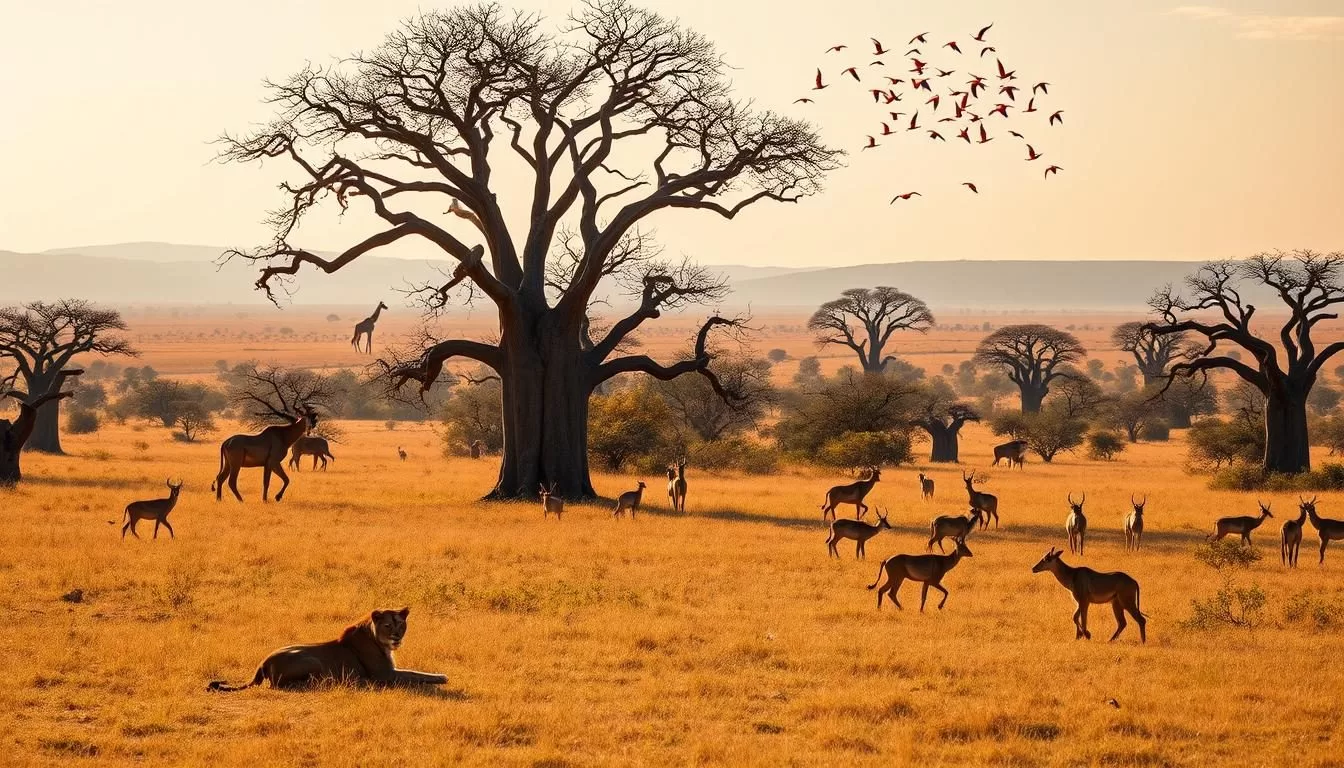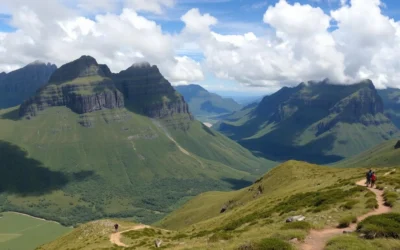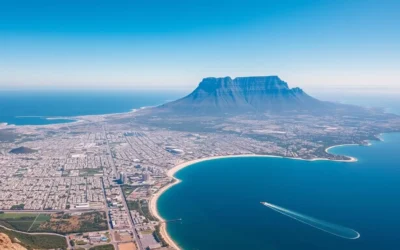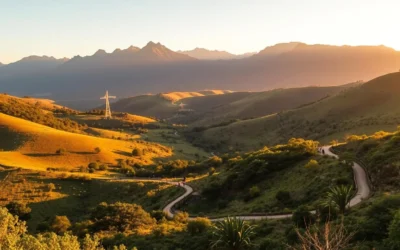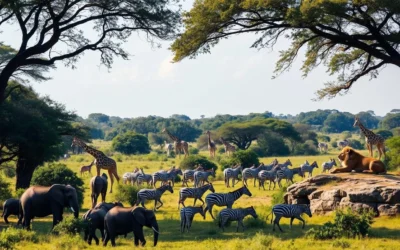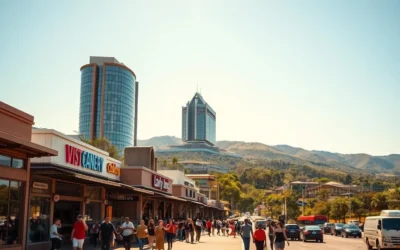✓ Accommodations✓ Flights✓ Rental Cars
You’re about to explore one of Africa’s most spectacular wilderness areas – a vast conservation zone that spans across South Africa and Botswana.
The Kgalagadi Transfrontier Park is renowned for its exceptional predator sightings, including the iconic black-maned lions, cheetahs, and leopards against a backdrop of striking red dunes. This unique desert ecosystem offers a true wilderness experience with relatively low visitor numbers, allowing for intimate wildlife encounters.
As you plan your visit, you’ll discover the best experiences and activities in this remarkable conservation area, from thrilling game drives to stargazing under pristine night skies.
Discovering the Kgalagadi Transfrontier Park
As you step into the Kgalagadi Transfrontier Park, you’re not just entering a wildlife reserve, but a pioneering conservation effort that has redefined the boundaries of wildlife protection in Africa. This remarkable park is the result of a historic merger between South Africa’s Kalahari Gemsbok National Park and Botswana’s Gemsbok National Park, coming together in 1999 to form a single, vast ecosystem.
![]()
What Makes Kgalagadi Unique
The Kgalagadi Transfrontier Park stands out as a trailblazing conservation initiative. By merging two national parks across international borders, it created Africa’s first official Transfrontier Park. This innovative approach allows wildlife to roam freely, following ancient migration routes unimpeded by political boundaries. The result is a more natural and diverse ecosystem.
Some key aspects that make Kgalagadi unique include:
- The freedom of wildlife to migrate across borders
- A unified management plan for both South African and Botswana areas
- A blend of developed infrastructure and remote wilderness experiences
The Transfrontier Conservation Concept
The transfrontier conservation concept is at the heart of Kgalagadi’s success. This collaborative approach between South Africa and Botswana involves managing the park as a single ecological unit. The benefits of this concept are multifaceted:
| Conservation Aspect | Description | Benefit |
|---|---|---|
| Unified Management | Streamlined conservation efforts across borders | Enhanced ecosystem health |
| Wildlife Mobility | Unrestricted movement for wildlife | More natural behavior and diversity |
| Ecological Integrity | Protection of shared natural heritage | Preservation of biodiversity |
This groundbreaking model has not only protected the rich biodiversity of the Kalahari region but has also served as a model for other transfrontier conservation areas across Africa. By working together, South Africa and Botswana have created a truly unique wildlife experience that benefits both the environment and visitors from around the world.
When to Visit Kgalagadi Transfrontier Park
Planning your visit to Kgalagadi Transfrontier Park requires understanding the best times to witness its incredible wildlife. The park is a year-round destination, but the experience varies greatly depending on the season.
Seasonal Wildlife Viewing Opportunities
Observing wildlife in Kgalagadi is great any time of the year. However, it becomes even more spectacular at the end of the rainy season, as a large number of animals gather near ponds, making them easier to spot. The rainy season, which typically occurs from December to April, brings lush landscapes and abundant birdlife, although it can occasionally result in flooded roads and more challenging driving conditions.
The dry season, on the other hand, offers excellent game viewing as animals congregate around waterholes. This concentration of wildlife makes it an ideal time for photography enthusiasts and those looking to spot a variety of species.
Weather Considerations and Best Months
The temperatures in Kgalagadi can be extreme, with summer days exceeding 40°C (104°F) and winter nights dropping below freezing. It’s advisable to avoid visiting during the peak summer months due to the high temperatures. The cooler months of May to September are considered the best time to visit Kgalagadi Transfrontier Park, as the cooler temperatures make for more comfortable game viewing, and animals remain active throughout the day.
Many experienced visitors recommend May to September (winter) as the ideal time to visit. If you’re visiting during summer (October-April), you’ll need to adapt your schedule to the heat, focusing on early morning and late afternoon activities when wildlife is most active. Photography enthusiasts often prefer the winter months when the air is clear and dust-free, providing excellent visibility and light conditions for capturing wildlife.
By considering these factors, you can plan your trip to Kgalagadi Transfrontier Park during the best time for your preferences, whether that’s for comfortable game viewing, photography, or experiencing the park’s unique landscapes.
How to Reach Kgalagadi Transfrontier Park
The journey to Kgalagadi begins with choosing the right entry point, whether it’s through South Africa or Namibia. Both options offer unique experiences and varying distances.
Entry Points and Gates
Kgalagadi Transfrontier Park has multiple entry gates, providing flexibility for travelers. You can enter the park through South Africa via the Twee Rivieren gate or through Namibia at the Mata Mata gate. Mata Mata is a popular entry point for those coming from Namibia.
- Entering through South Africa is convenient if you’re already in or near South Africa.
- The Mata Mata gate in Namibia is another viable option, especially if you’re flying into Windhoek, the capital city of Namibia.
When entering from Namibia, ensure you cross the international border by 4:30 PM.
| Entry Gate | Country | Nearest Major Town |
|---|---|---|
| Twee Rivieren | South Africa | Upington |
| Mata Mata | Namibia | Windhoek |
Transportation Options
To explore Kgalagadi, a reliable vehicle is essential. For the main roads between Twee Rivieren, Nossob, and Mata Mata, a high-clearance 2WD vehicle is sufficient during dry conditions. However, for wilderness camps or during the rainy season, a 4×4 vehicle is highly recommended.

- Many visitors rent vehicles in Upington (South Africa), Windhoek (Namibia), or Maun (Botswana).
- Specialized safari vehicles or 4×4 campers are popular choices for their versatility and comfort.
The main roads follow ancient riverbeds, making for relatively easy driving, while the dune roads offer more challenging terrain and unique wildlife viewing opportunities.
Accommodation Options in Kgalagadi
The Kgalagadi Transfrontier Park provides various accommodation choices, from rest camps to wilderness camps. You can select from a range of options that cater to different preferences, ensuring a comfortable and memorable stay.
Main Rest Camps
Main rest camps in Kgalagadi offer a comfortable stay with essential amenities. These camps are well-maintained and provide a convenient base for exploring the park. You can enjoy the facilities and services available, making your stay enjoyable and hassle-free.
Key Features: Essential amenities, convenient location, and well-maintained facilities.
Wilderness Camps and Unique Stays
For a more immersive experience, consider staying at one of the wilderness camps like Bitterpan, Grootkolk, or Urikaruus. These camps offer a more intimate connection with nature, with just 4-6 units each, providing solar-powered lighting and gas appliances. You can enjoy spectacular views of the surrounding landscape.
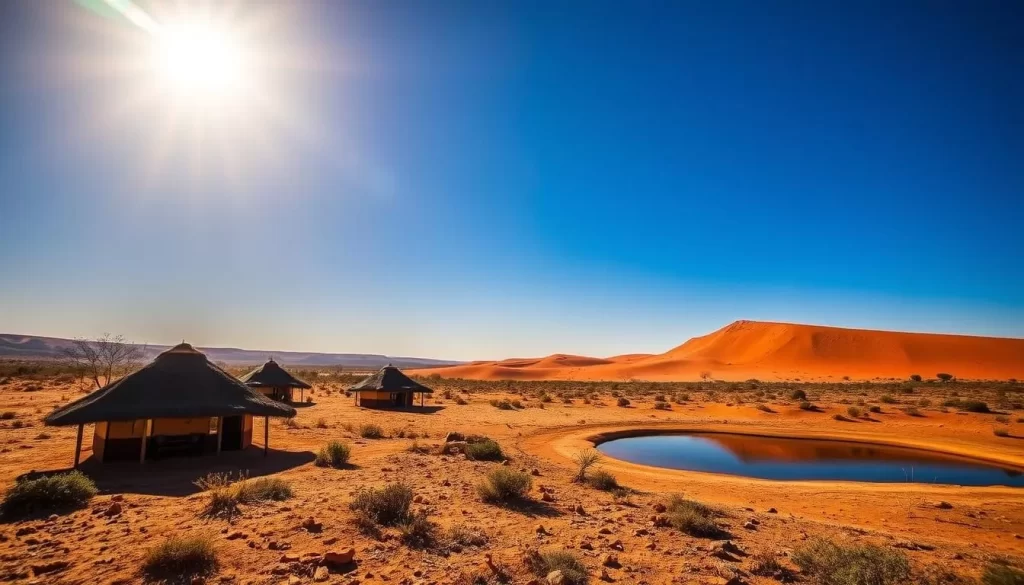
The wilderness camps are unfenced, allowing wildlife to roam freely. You might encounter lions, hyenas, or other animals right from your deck or around your campsite, making for a truly authentic safari experience. Some unique options include the elevated units at Urikaruus overlooking the Auob riverbed and the remote desert camp of Bitterpan, accessible only by 4×4.
For a more rugged adventure, the Botswana side of Kgalagadi offers primitive camping at sites like Mabuasehube and Kaa. You’ll need to be completely self-sufficient with your own water, food, and emergency supplies. This option allows you to experience the raw beauty and isolation of the Kalahari Desert.
Game Drives: The Ultimate Kgalagadi Experience
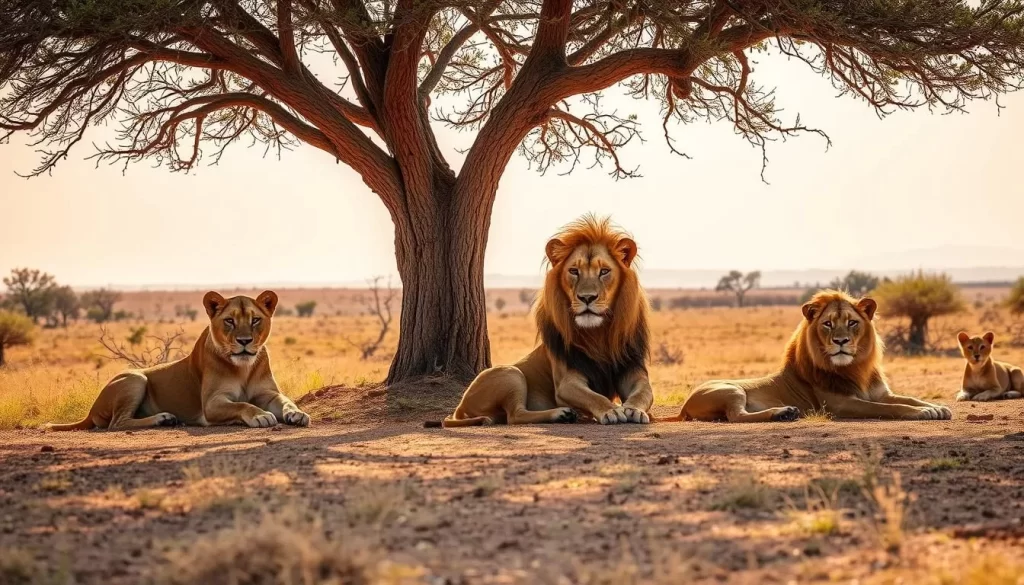
Game drives are a quintessential experience in Kgalagadi, offering a unique blend of excitement and connection with nature. The vast expanses of the Kalahari Desert provide a dramatic backdrop for spotting an array of wildlife, from the majestic predators to the graceful antelopes.
Self-Drive Safari Tips
For those opting for a self-drive safari, it’s essential to be prepared. Ensure your vehicle is suitable for the terrain, and always keep a safe distance from the wildlife. Morning and late afternoon drives are particularly rewarding due to the favorable lighting conditions and increased animal activity.
Keep an eye out for the diverse wildlife that inhabits the area around the main rest camps, such as Twee Rivieren and Nossob. The dry riverbeds are often hotspots for game viewing, as many animals congregate around these areas for water.
Guided Game Drive Options
You can complement your self-drive experience with guided game drives offered at the main rest camps, which provide valuable insights from knowledgeable rangers about the park’s wildlife and ecology. Morning, afternoon, and night drives are available from Twee Rivieren, Nossob, and Mata Mata camps, each offering different wildlife viewing opportunities based on the time of day.
- Night drives are particularly special as they provide your only chance to legally explore the park after dark, offering opportunities to spot nocturnal species like aardwolf, bat-eared fox, and African wildcat.
- Guided drives use open safari vehicles with elevated seating, providing better visibility than standard passenger cars, especially for photography.
- The expertise of professional guides increases your chances of spotting elusive predators and understanding their behaviors, making these excursions well worth the additional cost even if you’re primarily self-driving.
Whether you choose a self-drive or guided game drive, the experience will undoubtedly be a highlight of your visit to Kgalagadi Transfrontier Park, creating lifelong memories of the experience and the incredible wildlife you’ve encountered at the camp.
Guided Walking Safaris in the Kalahari
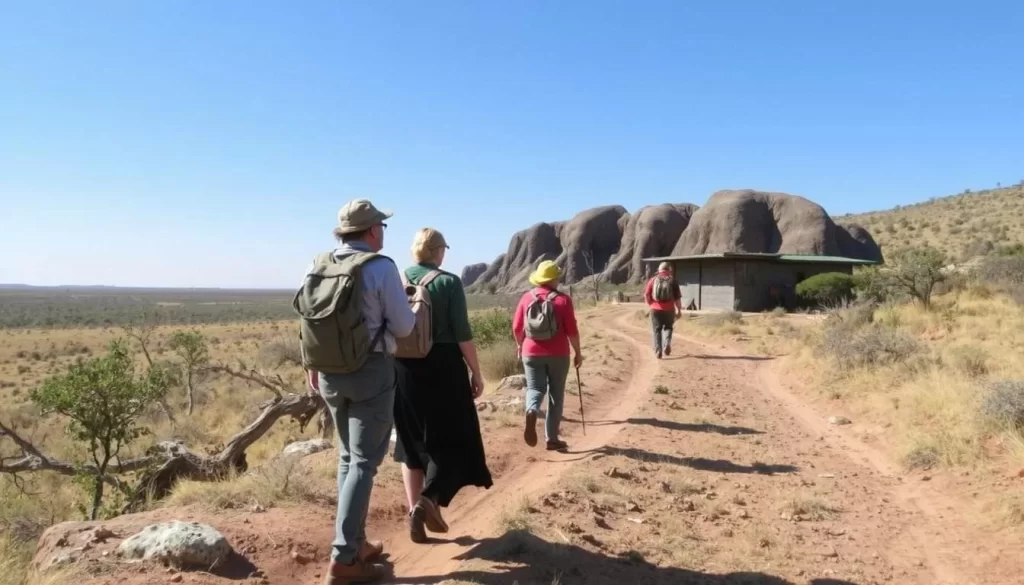
Explore the untamed beauty of the Kalahari on a guided walking safari, an experience that brings you closer to nature. The Kgalagadi Transfrontier Park offers a unique wilderness experience, allowing you to immerse yourself in the vast, untouched landscapes of the Kalahari.
What to Expect on a Walking Safari
On a guided walking safari in the Kgalagadi Transfrontier Park, you can expect an intimate encounter with the wilderness. These safaris are conducted by qualified, armed guides who are trained to interpret animal behavior, ensuring your safety in this predator-rich environment. You’ll walk through the open plains, learning about the flora and fauna, and potentially encountering a variety of wildlife.
The walks are generally not strenuous and are conducted in the morning when the temperatures are more favorable. You’ll need to wear neutral-colored clothing, comfortable walking shoes, a hat, and bring sun protection to ensure a comfortable experience.
Safety Considerations and Requirements
Safety is paramount on guided walking safaris. You must adhere to strict safety protocols, including following your guide’s instructions at all times and maintaining silence to avoid disturbing wildlife. These safaris typically have age restrictions (usually a minimum of 12-16 years) and require a reasonable level of fitness.
It’s also important to note that walking safaris must be booked in advance due to limited availability and small group sizes, usually a maximum of 8 participants, to minimize environmental impact and ensure a quality experience.
Stargazing in Kgalagadi Transfrontier Park

Under the dark skies of Kgalagadi, the stars shine brighter than ever before. The remote location and minimal light pollution make stargazing one of the most magical things to do in Kgalagadi Transfrontier Park. Once the sun sets, the desert sky transforms into a celestial showcase that will leave you breathless.
Many camps within the Kgalagadi Transfrontier Park offer special stargazing programs, with guides pointing out constellations and sharing local mythology about the night sky. The best stargazing opportunities come during the dry winter months when the air is crisp and clear.
Best Locations for Night Sky Viewing
The park offers several ideal locations for stargazing, with minimal obstructions and optimal views of the night sky. Some of the best sites for stargazing include areas around the main rest camps and designated wilderness camps.
When camping in these areas, you can enjoy the night sky without any distractions, making for a truly unforgettable experience.
Photography Tips for Capturing the Night Sky
For photography enthusiasts, capturing the night sky is one of the most rewarding things to do in Kgalagadi Transfrontier Park, yielding spectacular images of the Milky Way arching over the iconic silhouettes of camel thorn trees. To capture the magnificent night skies, you’ll need specific equipment, including a camera with manual settings, a sturdy tripod, and ideally a wide-angle lens with a large maximum aperture.
- Set your camera to manual mode with a high ISO (typically 1600-3200), wide aperture (f/2.8-f/4), and long exposure time (15-30 seconds).
- Including landscape elements like silhouetted trees or dunes creates more compelling night sky compositions.
- Plan your night photography around the lunar cycle for the best results.
Wildlife Spotting: Predators and Prey
Exploring the Kgalagadi Transfrontier Park, you’ll have the opportunity to witness the intricate dynamics between predators and prey in this unique desert ecosystem. The park is home to a diverse range of wildlife, adapted to the harsh conditions of the Kalahari Desert.
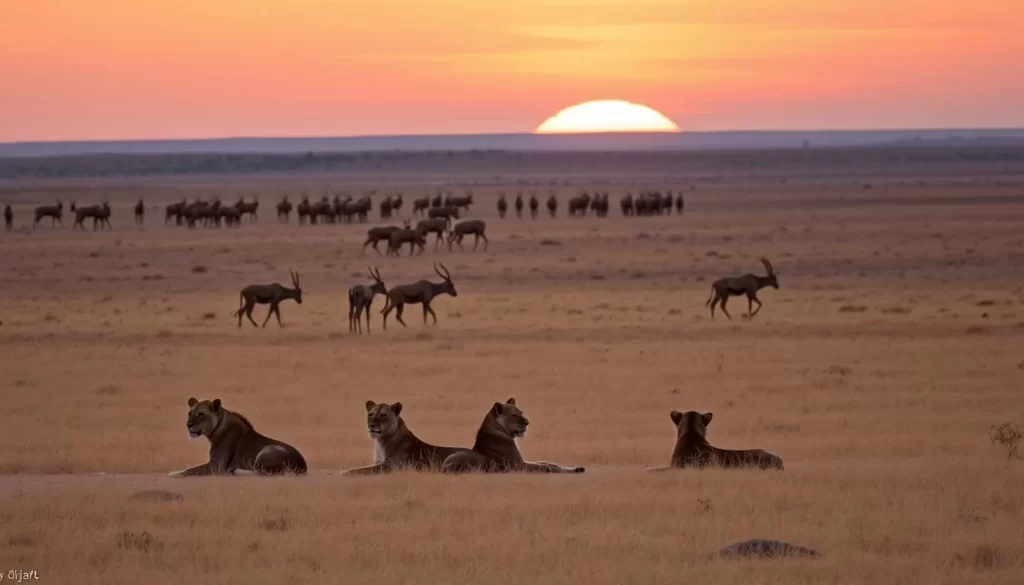
Big Cats of the Kalahari
The Kgalagadi Transfrontier Park is a sanctuary for big cats, including the majestic leopard, the powerful lion, and the elusive cheetah. These predators roam the desert landscape, preying on unsuspecting antelope and other herbivores. The park’s open plains and sparse vegetation make it an ideal location for spotting these magnificent creatures.
You may catch a glimpse of a lion pride lazing in the shade or a cheetah stalking its prey across the dunes. The leopard, with its distinctive spots, is a rare but thrilling sighting. The big cats of the Kalahari are a testament to the park’s rich biodiversity and the adaptability of these apex predators.
Other Notable Wildlife Species
Beyond the big cats, the Kgalagadi Transfrontier Park is home to a wide variety of other notable wildlife species. The park’s diverse array of antelope includes the iconic gemsbok (oryx), known for its striking black and white facial markings, as well as springbok, wildebeest, and red hartebeest. You may also spot warthogs and the occasional kudu as you explore the park’s vast expanses.
The park is also inhabited by smaller predators, such as hyenas, jackals, and bat-eared foxes. Meerkats, standing sentinel on their hind legs, are a favorite among visitors, particularly in the Auob riverbed area. The Kgalagadi Transfrontier Park offers a unique opportunity to observe these fascinating creatures in their natural habitat.
Kgalagadi Transfrontier Park, South Africa: Best Things to Do – Top Picks
As you explore the vast expanse of Kgalagadi Transfrontier Park, you’ll discover a plethora of exciting activities that make your trip truly unforgettable. The park offers a unique blend of wildlife viewing, historical exploration, and natural beauty, making it a must-visit destination for any traveler.
Visiting the Predator Centre at Nossob
The Predator Centre at Nossob is a fascinating stop on your Kgalagadi adventure. This centre provides insights into the conservation efforts and research activities focused on predators in the Kalahari ecosystem. You can learn about the big cats of the Kalahari, including lions, leopards, and cheetahs, and understand the challenges faced in their conservation.
During your visit, you can:
- Observe predators in a controlled environment.
- Learn about the research and conservation programs.
- Understand the importance of predator conservation in maintaining the ecological balance.
Exploring the Auchterlonie Museum
The Auchterlonie Museum is another significant attraction within the Kgalagadi Transfrontier Park. Located approximately 31 km north of Twee Rivieren along the Auob riverbed, this historical site offers a glimpse into the harsh pioneer life in the Kalahari over a century ago. The museum is a restored stone and thatch cottage that showcases period furniture, tools, and photographs, telling the story of early European settlers and the indigenous San people.
| Attraction | Location | Significance |
|---|---|---|
| Auchterlonie Museum | 31 km north of Twee Rivieren | Historical insight into pioneer life and indigenous San people |
| Predator Centre at Nossob | Nossob | Conservation and research on Kalahari predators |
By visiting these attractions, you can enrich your understanding of the Kgalagadi Transfrontier Park, appreciating both its natural beauty and historical significance. Whether you’re interested in wildlife spotting or exploring the region’s history, Kgalagadi has something to offer.
Bird Watching in the Kgalagadi
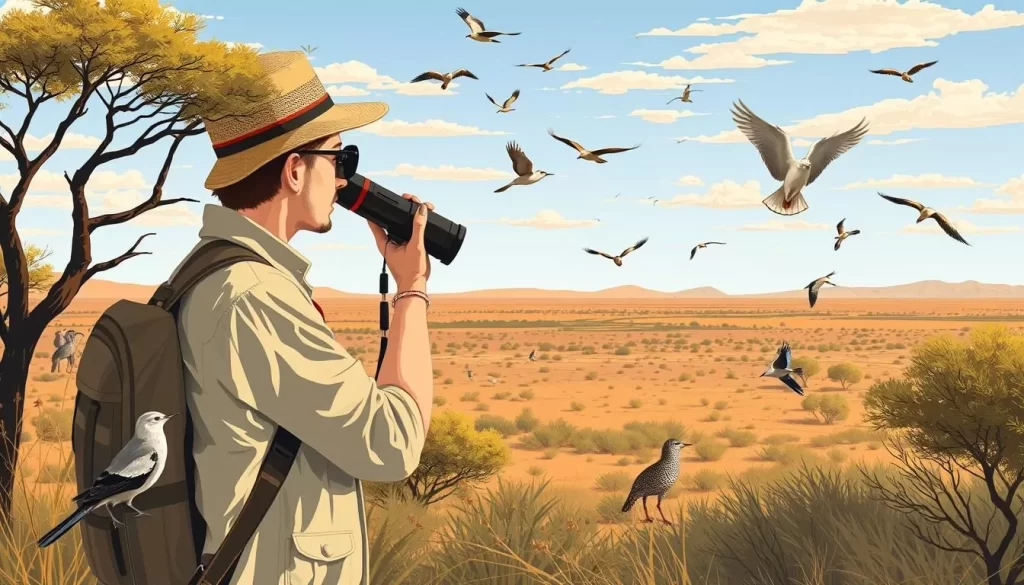
As a bird-watcher’s paradise, the Kgalagadi Transfrontier Park offers an incredible array of species to discover. With over 300 species recorded, roughly half of which are year-round residents or regular visitors, you can witness a diverse range of birds, from the majestic ostrich, the largest bird in the world, to the mischievous hornbills and the kori bustard, the world’s heaviest flying bird.
Raptors and Birds of Prey
The Kgalagadi Transfrontier Park is particularly renowned for its raptor species. You’ll have the opportunity to observe a variety of birds of prey, making it a haven for those interested in these magnificent creatures. The park’s diverse landscape and climate support a wide range of raptors, providing a unique experience for bird enthusiasts.
Best Birding Spots in the Park
Some of the top birding locations in the Kgalagadi Transfrontier Park include the waterholes, such as Cubitje Quap, Kwang, and Nossob, which are particularly productive for observing both raptors and other species. The Nossob bird hide is also a must-visit, offering excellent opportunities for close-up observation and photography, especially during the early morning and late afternoon. Additionally, the Auob riverbed and the camp gardens, particularly at Twee Rivieren, are worth exploring for their unique bird species.
Other notable birding spots include the sociable weaver nests, often built on telephone poles or large camel thorn trees, which frequently host pygmy falcons. By exploring these areas, you’ll be able to witness the incredible diversity of birdlife in the Kgalagadi Transfrontier Park.
Adventure Activities Beyond Wildlife
Beyond the wildlife, Kgalagadi Transfrontier Park offers a range of adventure activities that cater to different interests. Visitors can engage in exciting experiences that go beyond the traditional game drives and safaris.
Mountain Biking at Hakskeenpan
For the adventurous, mountain biking at Hakskeenpan is an exhilarating experience. This activity allows you to explore the park’s vast landscapes on two wheels, providing a unique perspective on the Kalahari environment. You can test your biking skills on the varied terrain, enjoying the thrill of navigating through the dunes and open plains.
4×4 Eco Trails
The Nossob 4×4 Eco Trail is a challenging adventure that spans 214 km, requiring about 3-4 days to complete. This trail is situated on the border of South Africa and Botswana, offering a unique experience as you drive through the sand dunes and sandy stretches between the Nossob and Auob riverbeds.
- You can test your 4×4 driving skills on the Nossob 4×4 Eco Trail, a 214 km route that traverses the dunes.
- This guided adventure requires overnight camping at designated wilderness sites with no facilities.
- A qualified guide is mandatory for this trail, ensuring your safety and providing insights into the ecology of the dune system.
| Trail Details | Requirements | Duration |
|---|---|---|
| Nossob 4×4 Eco Trail | 4×4 vehicle, guide, camping gear | 3-4 days |
| Mountain Biking at Hakskeenpan | Mountain bike, safety gear | Variable |
Essential Tips for Visiting Kgalagadi
As you prepare for your adventure in Kgalagadi Transfrontier Park, it’s essential to be aware of the unique challenges and opportunities that this extraordinary destination offers. The Kgalagadi Transfrontier Park is a vast and remote area, known for its difficult driving conditions and extreme weather. Understanding how to prepare and what to expect will significantly enhance your experience.
What to Pack
Packing the right gear is crucial for a successful trip to Kgalagadi. You’ll need to bring essentials such as sturdy clothing and footwear, suitable for the harsh desert environment. Don’t forget to include a first-aid kit, plenty of water, and sunscreen to protect yourself from the elements. Given the park’s remote location, it’s also wise to pack emergency supplies, including a spare tire, fuel, and a basic toolkit.
Safety Considerations
Safety should be your top priority when visiting Kgalagadi. The park’s vast open spaces and lack of immediate assistance mean that you need to be prepared for emergencies. Always travel with a partner or group when possible, and make sure someone knows your itinerary. Be aware of the weather conditions and plan your drives accordingly. In case of an emergency, stay calm and have a plan in place, including a means of communication such as a satellite phone.
Photography Tips
Capturing the beauty of Kgalagadi through photography requires some planning. The golden hours around sunrise and sunset offer the best light for photography, with the warm tones beautifully illuminating the red dunes and wildlife. A telephoto lens (at least 300mm) is essential for wildlife photography, while a wide-angle lens is perfect for capturing the expansive landscapes and night skies. Don’t forget to protect your gear from the dust with appropriate camera protection, including a good camera bag and lens cleaning supplies.
When photographing wildlife, consider the background and try to capture animals against the iconic red dunes or with golden grasses. The sparse vegetation and open terrain make it easier to spot wildlife, but patience and persistence are still necessary for the best shots.
Conclusion
As one of Africa’s most spectacular national parks, Kgalagadi Transfrontier Park delivers an unparalleled experience that combines stunning scenery with exceptional wildlife encounters.
You’ve now discovered why Kgalagadi Transfrontier Park stands as one of Africa’s most remarkable wildlife destinations, offering an authentic wilderness experience. The park’s unique blend of accessibility and remoteness provides the perfect balance for visitors seeking both comfort and adventure in this distinctive national park in South Africa.
Whether you’re drawn to the famous black-maned lions, the thrill of tracking cheetahs, or the peace of star-filled desert nights, Kgalagadi offers experiences that will linger long after your visit. By following the practical advice in this guide, you’ll be well-prepared to navigate this extraordinary landscape where South Africa and Botswana collaborate to protect a special ecosystem.
Your visit supports the ongoing protection of this vast transfrontier park, ensuring future generations can experience the magic of the Kalahari wilderness. In Kgalagadi Transfrontier Park, you’re not just visiting a park; you’re immersing yourself in a unique conservation effort that makes things to do in Kgalagadi Transfrontier Park truly unforgettable.
The above is subject to change.
Check back often to TRAVEL.COM for the latest travel tips and deals.
